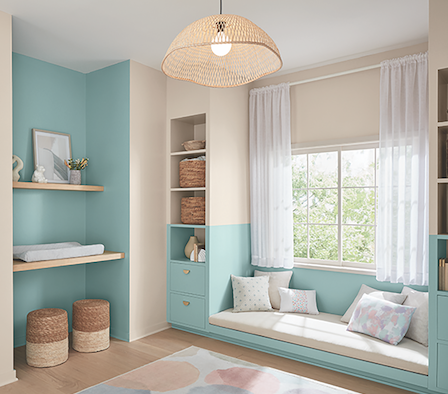“Colors seen have a significant effect on how humans think and behave, how they experience their physical world and whether they achieve the goals they’ve set for themselves,” says Dr. Sally Augustin, principal of La Grange, Illinois-based firm Design With Science. “Happily, for most of us, we do perceive color, and color can have a big effect on our mood, how our brain functions, how well we get along with other people, all sorts of different things.” When selecting a paint color for your room, consider how it could affect your mood and sleep in addition to its aesthetic. Daniel Ufland, co-founder of online furnishings marketplace Flitch, shares what colors aid relaxation and cause restlessness and offers tips for selecting a suitable paint color for your bedroom.

The Best Paint Colors for Your Bedroom
“Soft, cool tones like blue and lavender are known to have a calming effect, helping to lower heart rate and induce feelings of relaxation, contributing to improved sleep quality,” Ufland says. Perhaps unsurprising, given the predominance of soft blues used in branding of sleep products. According to a recent article on HunterLab’s website, a color measurement company, soft purple can have a physiological effect, creating “a feeling of calmness, lowering heart rate and blood pressure in some cases.” Warm grays and Earth-inspired tones like taupe or beige also have a positive influence on mood.
The Worst Paint Colors for Your Bedroom
“Conversely, bright, stimulating colors such as red or yellow may increase arousal levels and make it more difficult to unwind, potentially disrupting your sleep,” Ufland says. Shocking colors like bright red or yellow can be too harsh for a bedroom, making it hard to fall or stay asleep. The same is true of stark whites, which can be “too harsh or sterile,” according to Ufland, and intense blacks. Although black is linked to sophistication and can create a chic bedroom, “It can also absorb light and make a room feel smaller and more enclosed, potentially disrupting your sleep patterns,” Ufland says. It’s also advisable to stay away from dark brown for the same reasons. If opting for nature-inspired colors, choose ones on the lighter end of the spectrum.



Tips for Choosing a Bedroom Paint Color
Selecting one of the soft colors mentioned above is an easy way to create a tranquil bedroom atmosphere but it’s also important to stay true to your style. “If you’re drawn to bold or vibrant colors, consider incorporating them as accent pieces rather than painting the entire room,” Ufland says. “This allows you to enjoy pops of color without overwhelming the space.” When choosing a paint color, consider artificial and natural light. Test swatches to see how colors look throughout the day and with any lamps or overhead lights in your room. “Soft, diffused lighting complements calming colors and enhances the sleep-inducing atmosphere,” Ufland adds.







